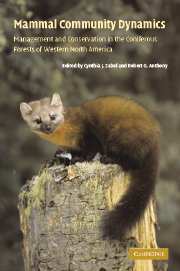 Mammal Community Dynamics
Mammal Community Dynamics Published online by Cambridge University Press: 15 December 2009
Small mammals are important components of western forest ecosystems. Their interactions with other organisms and the physical environment are complex. Small mammals are effective predators on seeds, vegetation, and insects, and may influence patterns of forest regeneration (Sullivan 1979, Christy and Mack 1984). Dispersal of seeds, mycorrhizal fungi, and nitrogen-fixing bacteria by small mammals may also affect plant diversity (Maser et al. 1978, Verts and Carraway 1998, Luoma et al. 2003). In addition, small mammals are prey for many carnivorous taxa, and changes in small-mammal abundance may affect the distribution and habitat use of their predators (Carey et al. 1992).
Understanding patterns of abundance and distribution of small mammals and how these species influence forest function and biodiversity are basic ecological problems relevant to both economic and conservation concerns. Exploration of these fundamental ecological relationships is challenging, however, because of the secretive nature of small mammals and their activities at night (e.g., deer mice (Peromyscus spp.)), below ground (e.g., gophers (Thomomys spp.) and moles (Scalopus spp.)), at the soil–vegetation interface (e.g., red-backed voles (Clethrionomys spp.) and shrews (Sorex spp.)), and in all levels of the canopy (e.g., flying squirrels (Glaucomys spp.) and tree squirrels (Tamiasciurus spp.)) (Aubry et al. 2003). In this chapter, we emphasize the forest-floor fauna, although not all species discussed confine themselves to the ground stratum (e.g., chipmunks (Tamias spp.) and woodrats (Neotoma spp.)).
To save this book to your Kindle, first ensure [email protected] is added to your Approved Personal Document E-mail List under your Personal Document Settings on the Manage Your Content and Devices page of your Amazon account. Then enter the ‘name’ part of your Kindle email address below. Find out more about saving to your Kindle.
Note you can select to save to either the @free.kindle.com or @kindle.com variations. ‘@free.kindle.com’ emails are free but can only be saved to your device when it is connected to wi-fi. ‘@kindle.com’ emails can be delivered even when you are not connected to wi-fi, but note that service fees apply.
Find out more about the Kindle Personal Document Service.
To save content items to your account, please confirm that you agree to abide by our usage policies. If this is the first time you use this feature, you will be asked to authorise Cambridge Core to connect with your account. Find out more about saving content to Dropbox.
To save content items to your account, please confirm that you agree to abide by our usage policies. If this is the first time you use this feature, you will be asked to authorise Cambridge Core to connect with your account. Find out more about saving content to Google Drive.